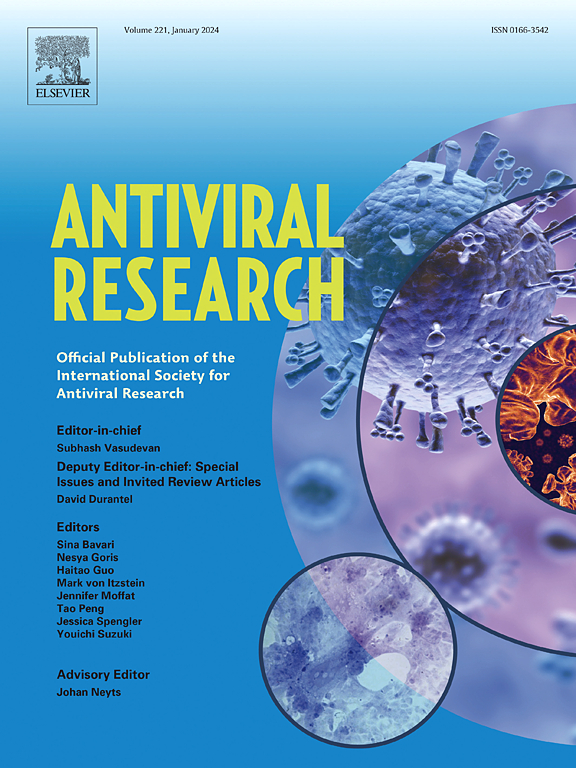HIV融合抑制剂LP-98的结构特征:抗病毒和耐药机制的见解
IF 4
2区 医学
Q1 PHARMACOLOGY & PHARMACY
引用次数: 0
摘要
LP-98是一种基于脂肽的HIV融合抑制剂,具有卓越的效力和长效抗病毒活性,目前处于II期临床试验中。在本研究中,我们阐明了LP-98抗病毒活性的结构基础和耐药机制。使用AlphaFold3,我们首先预测了LP-98和gp41衍生的NHR肽N44形成的六螺旋束(6-HB)结构,确定了介导螺旋间相互作用的关键残基。随后对LP-98/N44配合物的晶体学分析证实了这些结合特征,揭示了LP-98中的疏水残基簇,以及由15个氢键组成的网络,两个静电相互作用和一个盐桥,对6-HB结构的稳定至关重要。LP-98/N44晶体结构与预测的6-HB模型或LP-40/N44晶体结构的叠加分析为LP-98的结合模式提供了进一步的机制见解。此外,利用截断变体(LP-98-Y)对n端Tyr-127残基进行了结构和功能表征,证明其在抑制剂结合和抗病毒活性中起重要作用。值得注意的是,LP-98对携带NHR单或双突变的t20耐药HIV毒株的疗效显著降低。我们的结构模型揭示了这种耐药性的分子基础,为药物优化提供了关键的见解。总的来说,这些发现提供了LP-98抗病毒机制的详细结构理解,支持其作为有前途的下一代HIV融合抑制剂的继续发展。本文章由计算机程序翻译,如有差异,请以英文原文为准。
Structural characterization of HIV fusion inhibitor LP-98: Insights into antiviral and resistance mechanisms
LP-98 is a lipopeptide-based HIV fusion inhibitor with exceptional potency and long-acting antiviral activity, currently in phase II clinical trials. In this study, we elucidated the structural basis of LP-98's antiviral activity and resistance mechanisms. Using AlphaFold3, we first predicted the six-helical bundle (6-HB) structure formed by LP-98 and the gp41-derived NHR peptide N44, identifying key residues mediating interhelical interactions. Subsequent crystallographic analysis of the LP-98/N44 complex confirmed these binding features, revealing that a cluster of hydrophobic residues in LP-98, along with a network of 15 hydrogen bonds, two electrostatic interactions and a salt bridge, critically stabilizes the 6-HB structure. Superposition analyses of the LP-98/N44 crystal structure with either the predicted 6-HB model or the LP-40/N44 crystal structure provided further mechanistic insights into LP-98's binding mode. Additionally, structural and functional characterization of the N-terminal Tyr-127 residue using a truncated variant (LP-98-Y) demonstrated its essential role in inhibitor binding and antiviral activity. Notably, LP-98 exhibited significantly reduced efficacy against T20-resistant HIV strains harboring single or double mutations in NHR. Our structural models shed light on the molecular basis of this resistance, offering critical insights for drug optimization. Collectively, these findings provide a detailed structural understanding of LP-98's antiviral mechanism, supporting its continued development as a promising next-generation HIV fusion inhibitor.
求助全文
通过发布文献求助,成功后即可免费获取论文全文。
去求助
来源期刊

Antiviral research
医学-病毒学
CiteScore
17.10
自引率
3.90%
发文量
157
审稿时长
34 days
期刊介绍:
Antiviral Research is a journal that focuses on various aspects of controlling viral infections in both humans and animals. It is a platform for publishing research reports, short communications, review articles, and commentaries. The journal covers a wide range of topics including antiviral drugs, antibodies, and host-response modifiers. These topics encompass their synthesis, in vitro and in vivo testing, as well as mechanisms of action. Additionally, the journal also publishes studies on the development of new or improved vaccines against viral infections in humans. It delves into assessing the safety of drugs and vaccines, tracking the evolution of drug or vaccine-resistant viruses, and developing effective countermeasures. Another area of interest includes the identification and validation of new drug targets. The journal further explores laboratory animal models of viral diseases, investigates the pathogenesis of viral diseases, and examines the mechanisms by which viruses avoid host immune responses.
 求助内容:
求助内容: 应助结果提醒方式:
应助结果提醒方式:


